The beauty of the broken bucket
Published 5:35 pm Monday, March 8, 2021
|
Getting your Trinity Audio player ready...
|
BY ERIN SMITH
Sun Columnist
My parents have a small organic garden. It’s near – but not near enough – to the house to have access to water pipes. So they catch rain and carry that water from the rain catcher to their beloved tomato plants in big buckets. One of the buckets has a small crack in it, water leaking out in a small but steady stream so that you hurry so as to not have to make another trip.
That bucket needs to be replaced, but we all keep forgetting to buy a new one. It’s just a little hole, and it’s still usable if you hurry. Not perfect, but good enough. So it drips and never gets replaced, a cycle repeated season after season.
I was walking through that garden last August when I noticed the grass was dotted with purple vinca and yellow goatsbeard. Then I saw that the line of wildflowers drew a fairly straight shot from the rain catcher to the tomato plants. Near the tomatoes, there were even some wild daisies coming up. It took a second for the meaning to sink in. The cracked bucket had leaked enough water to spark a new line of growth.
Leonard Cohen wrote that the crack is how the light gets in. It never occurred to me that it can also be how the light gets out.
We’re coming up on the anniversary of the pandemic’s start. A year into this thing and life looks drastically different than it did before. We’re all a little cracked, cracked in the way that happens when your heart holds heavy stories of sorrow and loss. When you’re grieving for what’s been lost and still uncertain about what’s to come.
In Japan, the tradition of kintsugi mends broken things by filling the cracks with gold or silver. Kintsugi masters turn the crack into something beautiful.
But what if the cracks are already beautiful? What if our cracks are the places that our light leaks out? Perhaps they don’t always need to be fixed, only noticed. We often see our cracks with shame or judgment, as if they are failures, but those holes make us human. It’s the contrast. We cannot really know joy and beauty without sorrow and scratches. These oppositional forces create perspective.
This isn’t the narrative we’re sold. The messaging we hear, more and more, is that the bar is set to perfection, that attention is the same thing as affection. Social media is a daily barrage of pressure to be young, beautiful, thin, rich and successful. Our culture celebrates flawlessness and denigrates any sort of imperfection. If some Instagram influencer posted a photo of my mom’s gardening bucket, it would surely have its crack PhotoShopped out and its color enhanced with a filter. The overly high expectations we place on ourselves creates a toxic psychological environment that tells us faults, flaws and frailties must be avoided at all costs.
I have a collection of prisms from antique chandeliers hanging in the windows in my office. My favorite is one called a U-Drop and was originally part of a Victorian-style Library Lamp. There is a small, button-sized piece of round glass from which a four-inch spear-shaped prism hangs. My spear just happens to have a crack in the middle of it. When the afternoon light hits it just so, a riotous rainbow paints my office walls. The prism is already lovely, but the crack – the flaw that made it so affordable at the antique store years ago – turns it into something breathtakingly beautiful. The break makes it better.
Broken isn’t necessarily a liability. If we can see the inherent beauty in a broken bucket or cracked piece of glass, maybe we can see that same beauty in our own hearts and minds. Maybe our brokenness is watering a trail of flowers we’re currently too blind to see.






